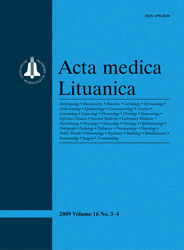Acta medica Lituanica
 ISSN 1392-0138 ISSN 2029-4174 (online) |
2011 m. Nr. 2 Fluorescence diagnostics of oral cancer
Background. Early detection of oral cancer improves the results of treatment. Fluorescence diagnostics (FD) helps to identify the real margins of malignant tumour. However, in some cases the artefactual fluorescence of healthy mucous appears. The aim of this study was to investigate the possibilities of fluorescence diagnostics of oral cancer as a more sensitive, effective and more specific method of FD.
Materials and methods. A total of 84 patients with morphologically verified malignant tumours underwent fluorescence diganostics. They were grouped into three groups. The first group consisted of 20 patients with malignant recurrent oral cancer, who underwent systemic (intravenous) photosensitizer administration (2.5 mg/kg). After 24–48 h, visual fluorescence diagnostics and spectroscopic measurements were performed. The second group consisted of 60 patients with different malignant tumours except oral cancer. They also underwent systemic (intravenous) photosensitizer administration (2.5 mg/kg). After 24–48 h, visual fluorescence diagnostics and spectroscopic measurements were performed. The third group consisted of 7 patients with malignant recurrent morphologically verified oral cancer; they underwent I/a FD. A catheter was inserted selectively into the feeding artery of the tumour via the superficial temporal artery. Photofrin (10 mg) was injected via the catheter directly into the tumour. Immediately after injection, 1 h and 4 h after injection, the visualization of mucosal tissues of the hypopharyngeal and oropharyngeal regions was performed under illumination of λ = 405 ± 5 nm light. Spectroscopic investigations of malignant and healthy tissues were also performed. Besides, there was the fourth group which consisted of 30 healthy volunteers. They were provided no treatment. The visual fluorescence diagnostics and spectroscopic measurements of healthy mucosa were performed for these volunteers. Results. A specific pink fluorescence of malignant tissue was noted while illuminating a tumour with violet light. The margins of fluorescence usually coincided with those of a malignant tumour. In doubtful cases, biopsy and morphological examination of the tissue were performed. All malignant tumours, except melanoma, showed a specific pink fluorescence when illuminated with violet light, and no fluorescence was noted in normal mucosa. However, in some cases glow artefacts were observed. We identified these “glow artefacts” – a nonspecific lilac fluorescence – in the healthy mucosa of 20 patients (in 6 patients from the first group and in 14 from the second group). Usually, artefactual fluorescence was noted in the gums (in 18 patients from 20) and at the basis of the tongue (in 11 patients from 20). There was no artefactual fluorescence in 7 patients who underwent I/a FD. Conclusions. Fluorescence diagnostics is useful for early detection of primary and recurrent malignant oral tumours, except melanoma. However, an artefactual fluorescence in the gums or in the basis of the tongue can appear. I/a FD allows avoiding this artefactual fluorescence. Keywords: fluorescence diagnostics, oral cancer, intra-arterial |
Issues:
2011 - Vol.18 No. 1, No. 2, No. 3, No. 4 2010 - Vol.17 No. 1-2, No. 3-4 2009 - Vol.16 No. 1-2, No. 3-4 2008 - Vol.15 No. 1, No. 2, No. 3, No. 4 2007 - Vol.14 No. 1, No. 2, No. 3, No. 4 2006 - Vol.13 No. 1, No. 2, No. 3, No. 4 2005 - Vol.12 No. 1, No. 2, No. 3, No. 4 2004 - Vol.11 No. 1, No. 2, No. 3, No. 4 2003 - Vol.10 No. 1, No. 2, No. 3, No. 4 2002 - Vol.9 No. 1, No. 2, No. 3, No. 4 2001 - Vol.8 No. 1, No. 2, No. 3, No. 4 |